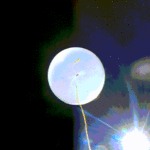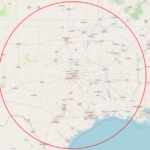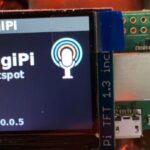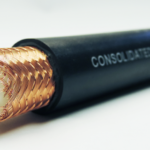By Jon Suehiro NN5T

You see this image on RWK home page – https://www.k5rwk.org/ .
But what does it mean? You also hear about Solar Cycle 25. What do you need to know about the current propagation and solar conditions?
This graphic is updated several times a day and contains the latest relevant data and statistics that are relevant to ham radio propagation. Ideally, you should be able to look at this and get a good feeling for HF band conditions. But how do you use this data?
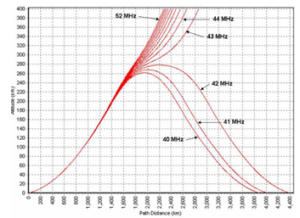
MUF: Max Usable Frequency – signal is hitting ionosphere and passing through (gone to space) above MUF, and reflected(refracted) back to Earth below the MUF. You can see the approximate MUF on the graph to the left that shows the various altitudes that signals at the plotted frequencies are refracted in the ionosphere and travel back towards the earth. At some frequency (in this case 43 MHz), the refraction is no longer enough to return to the earth, so it would be above the MUF
The MUF varies continuously and is different throughout the world, but possibly 7 ~ 8MHz at the minimum solar activity and goes up to 50 ~ 60MHz at the peak of the solar cycle.
You can see near real-time (every few minutes) readings of the MUF taken by Ionosondes here: https://region6armymars.org/resources/solarweather.php
Another detailed worldview of MUF is here: https://prop.kc2g.com/
SFI: Solar Flux Index is roughly equivalent to actual Sunspot Number (SN) so that the benefit is not needed to measure visually like SN – The solar flux is measured in solar flux units (SFU) and is the amount of radio noise or flux that is emitted at a frequency of 2,800 MHz (10.7 cm). The Penticton Radio Observatory in British Columbia, Canada reports this measure daily. SFI is closely related to F2 region ionosphere activity and best to predict HF DX propagation (SN is simply the result of visual count, and no need to try to see Sun in rainy days if we use SFI instead).
SFI in 2020 remained near 67 ~ 68 which was at the bottom of the solar cycle (in between 24 and 25, the actual bottom was announced as Nov. 2019). 10 meter band was completely dead other than the short Sporadic E openings, and 15 meter was occasionally open only toward South America (Transequatorialpropagation – TEP).
By the way, Sporadic E is totally not related to solar activity. We can expect opening of EU and JA on 6 meter even during the bottom of the solar cycle. That’s why 6 meter is called the Magic Band. For MUF to move up to 50MHz for normal DX through F2 layer, SFI must be close to minimum 200! I was able to work 22 entities in last Summer on 6 meter while SFI was 68.
The bottom line is the higher solar activity, the higher ionization in Earth ionosphere (D, E and F layers) so that long distance propagation at the higher frequency can be expected. At night time, the ionization will slow down, and lower the MUF, thus HF DX activity moves down to low bands.

A and K-index: Earth Geomagnetic Activity – disturbance in earth geomagnetic field. Occasionally the sun shoots out a solar flare and Earth’s magnetic field is disturbed. “A” index is the actual measured data but varies in the wide range. “K” index is the smoothed-out number, referred to and reported as the “planetary K index”. When you see the K index higher than 5, it is considered storm condition and the result is bad HF propagation. If we are expecting solar storm conditions, can you tell the difference if you are listening HF?
During the storm condition, Aurora is typically observed. In the HF propagation, you could hear unexpected high latitudes areas like Scandinavia or Siberia while band is dead by the Aurora reflection.
Today’s latest planetary Kp Index, updated every three hours —https://services.swpc.noaa.gov/images/planetary-k-index.gif
If you want to read more about Solar Indices, you can read in ARRL September 2002 article (publicly available): http://www.arrl.org/files/file/Technology/tis/info/pdf/0209038.pdf
-…-
If you are one of those tough Low Band DX’ers, high SFI is not always welcome. You may be already getting environmental noise (like from arcing power line through groundwave). Currently atmosphere noise is minimum. As SFI progresses up, the atmosphere noise will be increased on top of the already noisy band.
One additional point on low-band – it is almost impossible to predict 160 meter propagation. The reason is 160 meter DX is largely reliant on how D and E layers are minimized in darkness so the signal can reach F layer without too much attenuation. After dark, D and E layers disappear from the atmosphere but unable to predict how much. If you do BCL (broadcast listening) on AM band, you know exactly.
Here’s another summary of Solar Effects on Ionospheric Propagation: https://austinhams.org/solarwxintro/
-…-
About the Solar Cycle

In Solar Cycle History, Cycle 19 is famous, Sunspot Number (SN) hit higher than 200 and 6 meter was open worldwide in AM days. When I got first licensed in 1971, 10 meter was open all day – remembering working DX even after midnight. I moved to North Texas, and my first station N5BQQ in small apartment on Spring Valley in 1979, I was able to work JA’s on 15 meter CW with Dipole stretched across my living room. I was active in Multi-multi contest stations in early ‘80’s, it was so much exciting to work 150+ JA stations per hour on 15 and 10 meters for hours! In early ‘90’s, I had 10 meter FM mobile (10W) and working JA stations on 29.600 every day on the way home.
More info: https://www.spaceweatherlive.com/en/solar-activity/solar-cycle/historical-solar-cycles.html

Cycle 25 update: Actual SN 51.5 vs. predicted 19.7 in September 2021. Typically, when solar activity starts rapidly at the new beginning, higher SN is expected than prediction in the new entire cycle.
https://www.swpc.noaa.gov/products/solar-cycle-progression
On October 6, 10 meter was open to Africa and many of us worked S9 Sao Tome DX-pedition.
A Final Thought on Modes : Don’t forget, if you are normally operating on SSB, compared to 1W FT8, you need 1+kW to be equivalent. That 31dB difference will really beat the conditions at any time.
Keep switching the band, find the best HF propagation. Good things are happening now. Hello ‘Here Comes the Sun’. Good DX and Contesting.
– 73 de Jon NN5T

